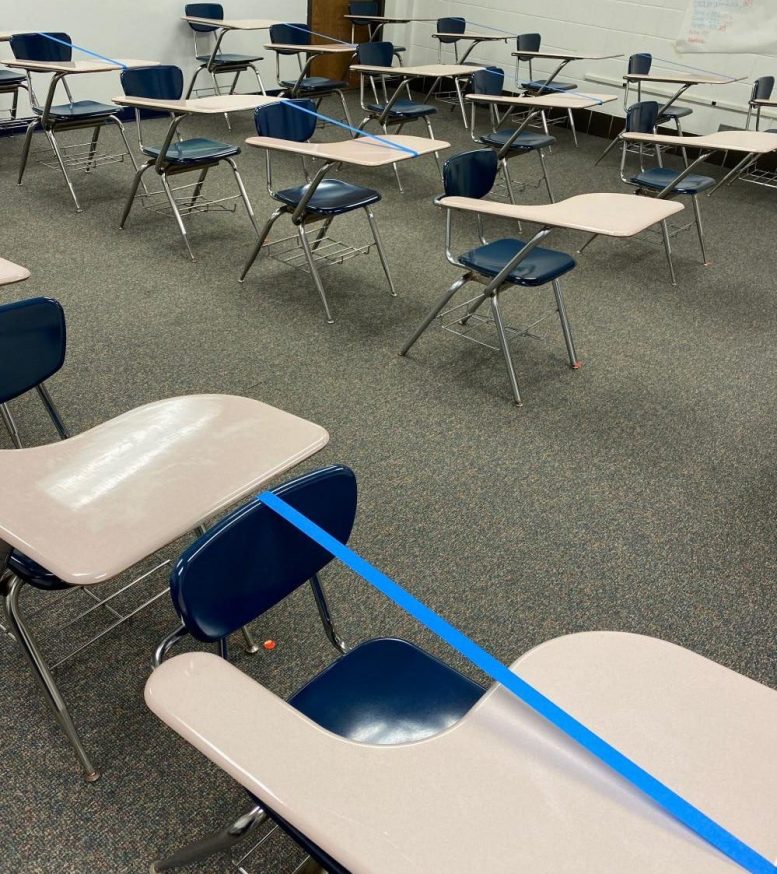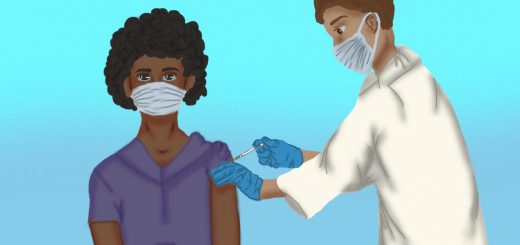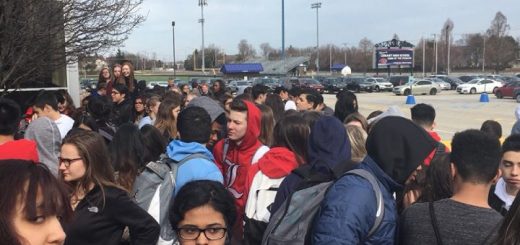District 211 plans transition to hybrid learning
 Courtesy of Mr. Nathan
Courtesy of Mr. Nathan Room 127 at Conant High School has been prepared for socially distant hybrid classes. Desks are taped off with floor stickers indicating 6 feet measurements.
Amidst confirmed cases of COVID-19 among students and staff in the buildings–and recent decisions by other local school districts to return to fully remote learning as a result of increased COVID positivity rates–District 211 continues its plan to transition to a hybrid learning scenario beginning Monday, October 26.
In separate emails to the staff, Conant principal Julie Nowak has confirmed four positive cases among Conant staff members and one positive case of a student who was in the building. Nowak said that the hybrid situation will evolve if the number of positive cases continue to increase.
“We have been following IDPH guidelines on contact tracing and letting people know about the situation,” Nowak said. “But as cases increase, we will constantly need to reassess our learning plans.”
District 211 Superintendent Dr. Lisa Small said that safety guidelines are in place to lower the risk of transmission of COVID-19. “There are a lot of protocols in place to keep students safe,” Small said, “including staying at home if you’re sick or not feeling well, following six feet social distancing, having a maximum of 50 people in large groups, wearing a mask at all times, and cleaning and disinfecting desks.”
Some D211 parents have expressed concerns about remote learning and pushed for the reopening of schools. At the September 17 Board of Education meeting, Hoffman Estates High School parent Kristen Steel said, “Since all remote learning has commenced, I have seen my children frustrated and at times angered, sad, and simply longing to be in school. My children are very involved and very happy human beings. They are not that way any more.”
Not all Conant students, however, plan to return to in-person learning. Sreedevi Prasad, ‘23, said, “I don’t think hybrid learning will be completely safe because it’s hard to enforce mask wearing and a six foot distance for all students at all times. I’ll be staying remote because I feel like the teachers are doing a great job teaching curriculum virtually, and it would be risky to go to school in person.”
The District sent a survey to families, asking them to indicate whether students planned to participate in hybrid learning or remain in remote learning for the rest of the semester. Using that data, students have been divided into two groups to attend school: Conant Strong and Cougar Pride. The Cougar Pride group will begin in-person learning next week.
According to Nowak, 70% of Conant students are participating in hybrid learning, and around 800 students will be in the building every day.
The administration has used data from the survey to design schedules for in-person learning. “We look at particular sections to see how many students are in the class, how many of them want to attend school in-person, and how many people can sit in the desks following social distancing. And we do this for every single class,” Small explained. “A lot of people don’t realize how much work goes into making this transition and process successful.”
In a hybrid scenario, before the school day begins, students attending in-person learning must complete the Wellness Screening Survey, which is sent daily through an email from the district. If students receive a red ‘X’ as part of the survey, they must stay home and can participate in remote learning if they feel well enough to do so. If students receive a green checkmark, they are allowed to go to school.
Buses will be loaded from the back, with one student per seat, and masks must be worn at all times. Students must show their green checkmark from the survey, have their IDs ready to be scanned, and wear a mask as they walk into the building. An electronic temperature reader, as opposed to a handheld scanner, will check students’ temperatures as they walk into the building to avoid crowding and long lines in hallways .
Students will transition between classes in thirds to follow safety protocols in the hallways. The passing period will continue to be 15 minutes, giving each group of students five minutes to get to their next class.
“When you get to your next class, there will most likely be students in that class, so continue to maintain a six feet distance. And this process is repeated for each passing period,” Small stated. Teachers will spray desks with a disinfectant during passing periods, and students will be asked to dry their own desk with a paper towel when they arrive at their next class.
When classes are over for the day, students will be able to pick up a lunch bag on their way out of the school. Students staying after school for academic support, activities, or athletics can also pick up lunch and eat in designated areas in the cafeteria.
Nowak said that staff members have been preparing for this transition since the summer. “Our faculty and staff have been in the building since school started and are aware of the protocol for themselves.” Last week, teachers participated in afternoon professional development days to prepare for hybrid learning, including the institute day on Friday, October 16. This week, teachers are practicing their schedules and routines as if students are in the building.
In an effort to keep students and staff safe, the district regularly tracks positivity data in the area. Small said, “I have weekly phone calls with the Cook County Department of Public Health, and we discuss the current situation. We look at data and track patterns weekly to stay up-to-date.”
Small indicated that students will play a role in the success of the hybrid model. “The staff has been practicing protocol, and we need to make sure students follow them [as well] to decrease the chance of transmitting disease on campus,” Small said.
Next semester’s learning situation, much like the current one, remains fluid. Small said, “It is impossible for me to predict with accuracy what’s going to happen three months from now. If I had to make a guess right now under the assumption that nothing changes in the next few months, I would say it’s most likely going to be hybrid or remote learning next semester.”
Ella Saputra contributed to this article.





Recent Comments